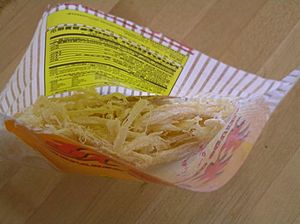Dried shredded squid facts for kids
Quick facts for kids Dried shredded squid |
|||||||||||||||
|---|---|---|---|---|---|---|---|---|---|---|---|---|---|---|---|
 |
|||||||||||||||
| Chinese name (by strand) | |||||||||||||||
| Traditional Chinese | 魷魚絲 | ||||||||||||||
| Simplified Chinese | 鱿鱼丝 | ||||||||||||||
| Hanyu Pinyin | yóu yú sī | ||||||||||||||
| Jyutping | jau4 jyu4*2 si1 | ||||||||||||||
| Literal meaning | squid strand | ||||||||||||||
|
|||||||||||||||
| Chinese name (by slice) | |||||||||||||||
| Traditional Chinese | 魷魚片 | ||||||||||||||
| Simplified Chinese | 鱿鱼片 | ||||||||||||||
| Hanyu Pinyin | yóu yú piàn | ||||||||||||||
| Jyutping | jau4 jyu4*2 pin3 | ||||||||||||||
|
|||||||||||||||
| Korean name | |||||||||||||||
| Hangul | 오징어채 | ||||||||||||||
|
|||||||||||||||
| Japanese name | |||||||||||||||
| Kanji | 鯣 | ||||||||||||||
| Kana | スルメ | ||||||||||||||
|
|||||||||||||||
Dried shredded squid is a popular snack made from dried squid or cuttlefish. It's seasoned and shredded, and you can find it in many coastal countries in Asia, as well as Russia and Hawaii. Sometimes people call it dried shredded cuttlefish.
Contents
Where Did It Come From?
Squid has always been a common food in coastal areas of East Asia and Southeast Asia. When this snack started being sold in other parts of the world, its Japanese name surume and Chinese name yóu yú sī were translated to "dried shredded squid" on packages.
This snack became very popular in Hong Kong in the 1970s. In Macau, it was even added to their famous almond biscuit. In China, it's a light snack sold in bags in many stores.
- In Japan, dried shredded squid is a popular otsumami (a snack eaten with drinks).
- In Korean cuisine, it's eaten as banchan (small side dishes). One dish is ojingeochae bokkeum. This is made by stir-frying dried shredded squid with gochujang (chili pepper paste), garlic, and mullyeot (a type of syrup).
- In Singapore, older generations loved this snack. It was sold in small local shops called Mama shops. A company called Ken Ken even called it the "Chewing gum of the Orientals" in the 1970s.
How Is It Made?
Making dried shredded squid involves several steps:
- First, squid from the Northern Pacific is cleaned and skinned.
- Then, it's cooked in hot water (65–80 °C) for a few minutes.
- After cooling, the squid is grated and seasoned. Common seasonings include sugar, salt, and other flavor enhancers.
- Next, it's dried at a warm temperature (40–45 °C) for many hours. This removes most of the water.
- The squid is then stored in a cold room for a couple of weeks.
- Finally, it's dried again at a higher temperature. Machines then shred it, and it's seasoned one more time. This makes the squid yellow or brownish.
How Is It Packaged?
Today, you'll usually find dried shredded squid in sealed bags. These bags keep the squid chewy and fresh. Different brands might add different amounts of MSG for flavor.
Sometimes, you can still find unpackaged versions in special shops. These are often sold next to beef jerky.
Cultural Importance
The Ken Ken brand of dried shredded cuttlefish was very popular in Singapore. It was known by its catchy phrase, "Chewing gum of the Orientals." This snack was a favorite for many older Singaporeans growing up. It was a common treat before modern snacks like chocolates and chips became popular.
You could buy these snacks at mamak shops. These were small local stores that sold everyday items and snacks. They were a big part of the community in old Singapore. Even though big supermarkets are more common now, Ken Ken Cuttlefish is still available in Singapore. It's a nostalgic snack that reminds many older Singaporeans of their childhood.
Taste and Texture
People describe dried shredded squid as chewy. It gives your jaws a bit of a workout! It often has a mix of sweet, spicy, and salty flavors, along with a unique seafood taste.
Images for kids
See also
 In Spanish: Tiras de calamar seco para niños
In Spanish: Tiras de calamar seco para niños



